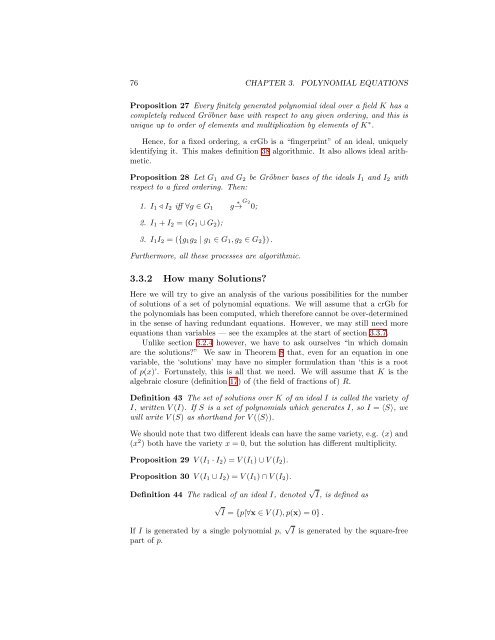Contents - Student subdomain for University of Bath
Contents - Student subdomain for University of Bath
Contents - Student subdomain for University of Bath
Create successful ePaper yourself
Turn your PDF publications into a flip-book with our unique Google optimized e-Paper software.
76 CHAPTER 3. POLYNOMIAL EQUATIONS<br />
Proposition 27 Every finitely generated polynomial ideal over a field K has a<br />
completely reduced Gröbner base with respect to any given ordering, and this is<br />
unique up to order <strong>of</strong> elements and multiplication by elements <strong>of</strong> K ∗ .<br />
Hence, <strong>for</strong> a fixed ordering, a crGb is a “fingerprint” <strong>of</strong> an ideal, uniquely<br />
identifying it. This makes definition 38 algorithmic. It also allows ideal arithmetic.<br />
Proposition 28 Let G 1 and G 2 be Gröbner bases <strong>of</strong> the ideals I 1 and I 2 with<br />
respect to a fixed ordering. Then:<br />
1. I 1 ⊳ I 2 iff ∀g ∈ G 1 g ∗ → G2 0;<br />
2. I 1 + I 2 = (G 1 ∪ G 2 );<br />
3. I 1 I 2 = ({g 1 g 2 | g 1 ∈ G 1 , g 2 ∈ G 2 }) .<br />
Furthermore, all these processes are algorithmic.<br />
3.3.2 How many Solutions?<br />
Here we will try to give an analysis <strong>of</strong> the various possibilities <strong>for</strong> the number<br />
<strong>of</strong> solutions <strong>of</strong> a set <strong>of</strong> polynomial equations. We will assume that a crGb <strong>for</strong><br />
the polynomials has been computed, which there<strong>for</strong>e cannot be over-determined<br />
in the sense <strong>of</strong> having redundant equations. However, we may still need more<br />
equations than variables — see the examples at the start <strong>of</strong> section 3.3.7.<br />
Unlike section 3.2.4 however, we have to ask ourselves “in which domain<br />
are the solutions?” We saw in Theorem 8 that, even <strong>for</strong> an equation in one<br />
variable, the ‘solutions’ may have no simpler <strong>for</strong>mulation than ‘this is a root<br />
<strong>of</strong> p(x)’. Fortunately, this is all that we need. We will assume that K is the<br />
algebraic closure (definition 17) <strong>of</strong> (the field <strong>of</strong> fractions <strong>of</strong>) R.<br />
Definition 43 The set <strong>of</strong> solutions over K <strong>of</strong> an ideal I is called the variety <strong>of</strong><br />
I, written V (I). If S is a set <strong>of</strong> polynomials which generates I, so I = 〈S〉, we<br />
will write V (S) as shorthand <strong>for</strong> V (〈S〉).<br />
We should note that two different ideals can have the same variety, e.g. (x) and<br />
(x 2 ) both have the variety x = 0, but the solution has different multiplicity.<br />
Proposition 29 V (I 1 · I 2 ) = V (I 1 ) ∪ V (I 2 ).<br />
Proposition 30 V (I 1 ∪ I 2 ) = V (I 1 ) ∩ V (I 2 ).<br />
Definition 44 The radical <strong>of</strong> an ideal I, denoted √ I, is defined as<br />
√<br />
I = {p|∀x ∈ V (I), p(x) = 0} .<br />
If I is generated by a single polynomial p, √ I is generated by the square-free<br />
part <strong>of</strong> p.












![[Luyben] Process Mod.. - Student subdomain for University of Bath](https://img.yumpu.com/26471077/1/171x260/luyben-process-mod-student-subdomain-for-university-of-bath.jpg?quality=85)



